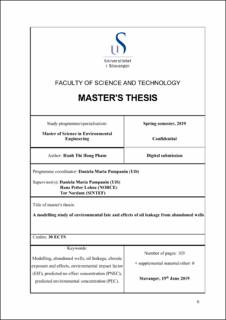| dc.contributor.advisor | Pampanin, Daniela Maria | |
| dc.contributor.advisor | Lohne, Hans Petter | |
| dc.contributor.advisor | Nordam, Tor | |
| dc.contributor.author | Pham, Hanh Thi Hong | |
| dc.date.accessioned | 2023-01-05T13:58:49Z | |
| dc.date.available | 2023-01-05T13:58:49Z | |
| dc.date.issued | 2019-06-15 | |
| dc.identifier.uri | https://hdl.handle.net/11250/3041315 | |
| dc.description | Master's thesis in Environmental Engineering. | en_US |
| dc.description.abstract | Potential environmental consequences of oil leakages are taken into consideration in the ongoing development of plug and abandonment (P&A) activities on the Norwegian Continental Shelf (NCS). The P&A on the NCS has been required to reach a “zero leakage” target, while environmental regulations and risk monitoring for permanent abandonment are still needed. Thus, a modelling study of fate and effects of oil leakage from abandoned wells is the topic of this thesis. The research covers an investigation into applicable models and scenario modelling of a theoretical oil leak case study on the NCS. Lessons from natural oil seeps are utilized to understand potential exposure and effects of the oil leakages. In order to estimate the chronic biological exposure and effects from continuous low-rate oil leakages, the modelling is executed via a software developed by SINTEF. An Environmental Impact Factor (EIF) tool is used to compute impacted areas and risks of different oil droplets.
The results show that the smaller the droplets are, the greater the impact they have on the environment. EIFs or risks develop in time and become more stable over long periods, meanwhile impacted areas with risk > 5% become denser in a certain location of a few hundred meters from the release site. Chronic exposure and effects on organisms potentially occur with a steady state effect over a long period. Some unacceptable risks, which are exceeding the conventional accepted level of 5%, appear surrounding the release site, indicating a need of mitigation measures. Under variation of currents and winds, dilution, dispersion, evaporation, oxidation and biodegradation are parts of the influence processes on fate and effects of the oil leakage. Toxic hydrocarbons including polycyclic aromatic hydrocarbon, naphthalene 1, C4 benzene and C7 to C9 saturates should be of concern regarding hydrocarbon contributions to risks. | en_US |
| dc.language.iso | eng | en_US |
| dc.publisher | University of Stavanger, Norway | en_US |
| dc.relation.ispartofseries | Masteroppgave/UIS-TN-IKBM/2019; | |
| dc.subject | abandoned wells | en_US |
| dc.subject | environmental impact factor (EIF) | en_US |
| dc.subject | oil leakage | en_US |
| dc.subject | predicted environmental concentration (PEC) | en_US |
| dc.subject | environmental engineering | en_US |
| dc.title | A modelling study of environmental fate and effects of oil leakage from abandoned wells | en_US |
| dc.type | Master thesis | en_US |
| dc.description.version | publishedVersion | en_US |
| dc.subject.nsi | VDP::Matematikk og Naturvitenskap: 400 | en_US |
